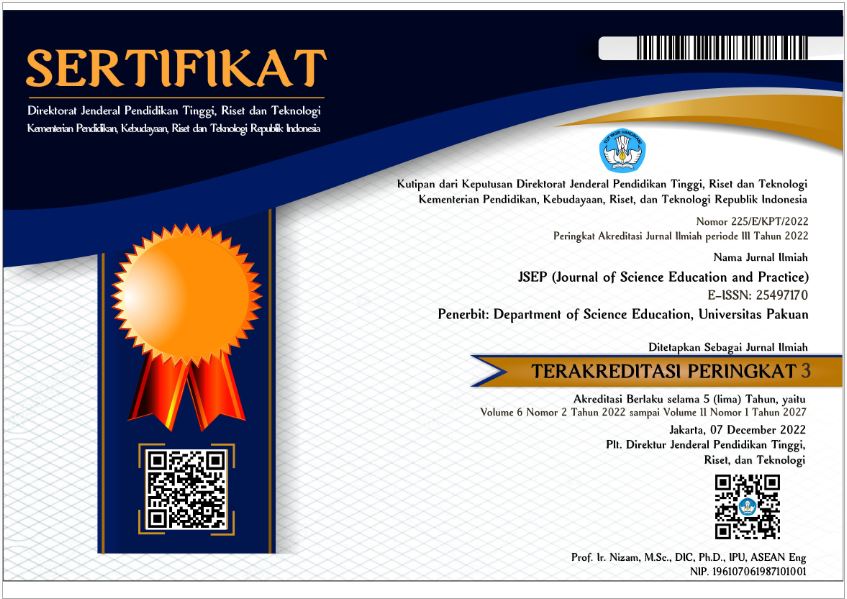ADDITIONAL MENU
Webbed Type of Integrated Science Learning on the Theme of Environmental Pollution to Improve Students Scientific Literacy
Abstract
Keywords
References
Ayotte-Beaudet, J.-P., Potvin, P., & Riopel, M. (2019). Factors Related to Middle School Students Situational Interest in Science in Outdoor Lesson in Their School Immediate Surrounding. International Journal of Environmental and Science Education, 14(1), 1332.
Chumdari, Anitah, S., & Suryani, N. (2018). Inquiry-based Integrated Thematic Instruction on Character Education of Primary School Students. International Journal of Education and Literacy Studies, 6(2), 6978. https://doi.org/10.7575/aiac.ijels.v.6n.2p.69
Dharma, K. K. (2015). Metodologi Penelitian Keperawatan: Panduan Melaksanakan dan Menerapkan Hasil Penelitian. Trans InfoMedia.
Fogarty, R. (2009). How to Integrate the Curricula (3 ed.). Library of Congress Cataloging in Publication Data.
Frantz, C. M., & Mayer, F. S. (2014). The Importance of Connection to Nature in Assessing Environmental Education Programs. Studies in Educational Evaluation, 41(June), 8589. https://doi.org/10.1016/j.stueduc.2013.10.001
Gormally, C., Brickman, P., & Lutz, M. (2012). Literacy skills (TOSLS): Measuring Undergraduates Evaluation of Scientific Information and Arguments. CBE—Life Sciences Education, 11(4), 364377.
Gresnigt, R., Taconis, R., Van Keulen, H., Gravemeijer, K., & Baartman, L. (2014). Promoting Science and Technology in Primary Education: A Review of Integrated Curricula. Studies in Science Education, 50(1), 4784.
Hake, R. (1999). Analyzing Change/Gain Scores. Area-D American Education Research Associations Division.D, Measurement, and Research Methodology.
Hodson, D. (2014). Learning Science, Learning about Science, Doing Science: Different Goals Demand Different Learning Methods. International Journal of Science Education, 36(15), 25342553. https://doi.org/10.1080/09500693.2014.899722
Ibrahim, N. H., Surif, J., Hui, K. P., & Yaakub, S. (2014). Typical†Teaching Method Applied in Chemistry Experiment. Procedia-Social and Behavioral Sciences, 116 (February), 49464954. https://doi.org/10.1016/j.sbspro.2014.01.1054
Kim, D., & Bolger, M. (2017). Analysis of Korean Elementary Pre-service Teachers Changing Attitudes about Integrated STEAM Pedagogy Through Developing Lesson Plans. International Journal of Science and Mathematics Education, 15(4), 587605.
Klucevsek, K. (2017). The Intersection of Information and Science Literacy. Communications in Information Literacy, 11(2), 354365.
Lederman, N. ., Lederman, J. S., & Antink, A. (2013). Nature of Science and Scientific Inquiry as Contexts for the Learning of Science and Achievement of Scientific Literacy. International Journal of Education in Mathematics, Science and Technology, 1(3), 138147.
Liu, M.-C., & Wang, J.-Y. (2010). Investigating Knowledge Integration in Web-based Thematic Learning using Concept Mapping Assessment. Journal of Educational Technology & Society, 13(2), 2539.
Mullenbach, L. E., & Green, G. T. (2018). Can Environmental Education Increase Student-Athletes Environmental Behaviors? Environmental Education Research, 24(3), 427444. https://doi.org/10.1080/13504622.2016.1241218
Nazarenko, A. V, & Kolesnik, A. I. (2018). Raising Environmental Awareness of Future Teachers. International Journal of Instruction, 11(3), 6376.
Novianti, N., & Fitriani, A. (2016). Penerapan Pembelajaran IPA Terpadu Tipe Webbed dan Shared untuk Meningkatkan Keterampilan Proses. EDUSAINS, 8(1), 7482.
OECD. (2017). PISA 2015: Assessment and Analytical Framework : science, reading, mathematics, financial literacy, and collaborative problem-solving. OECD Publishing.
Puspita, R. D., Hoerudin, C. W., & Yudiantara, R. A. (2020). Integrating Thematic Instruction Using Webbed Curricula Model to Improve Students Reading Comprehension on Informational Text. Anatolian Journal of Education, 5(2), 118.
Sugiyono. (2015). Statistik untuk Penelitian. CV Alfabeta.
Suryaneza, H., & Permanasari, A. (2016). Penerapan Pembelajaran IPA Terpadu Menggunakan Model Webbed untuk Meningkatkan Literasi Sains Siswa. Edusains UIN Syarif Hidayatullah, 8(1), 3647.
Tamassia, L., & Frans, R. (2014). Does Integrated Science Education Improve Scientific Literacy. Journal of the European Teacher Education Network, 9, 131141.
Trianto. (2010). Model Pembelajaran Terpadu : Konsep, Strategis dan Implementasinya dalam KTSP. PT Bumi Aksara.
Turiman, P., Omar, J., Daud, A. M., & Osman, K. (2012). Fostering the 21st Century Skills Through Scientific Literacy and Science Process Skills. Procedia-Social and Behavioral Sciences, 59(October), 110116. https://doi.org/10.1016/j.sbspro.2012.09.253
Utomo, A. P., Hasanah, L., Hariyadi, S., Narulita, E., & Umamah, N. (2020). The Effectiveness of STEAM-Based Biotechnology Module Equipped with Flash Animation for Biology Learning in High School. International Journal of Instruction, 13(2), 463476.
Valladares, L. (2021). Scientific Literacy and Social Transformation. Science & Education, 30(3), 557587.
Wright, K. L., Franks, A. D., Kuo, L.-J., McTigue, E. M., & Serrano, J. (2016). Both Theory and Practice: Science Literacy Instruction and Theories of Reading. International Journal of Science and Mathematics Education, 14(7), 12751292. https://doi.org/10.1080/09500690601075629
YeÅŸilyurt, M., BalakoÄŸlu, M. O., & Erol, M. (2020). The Impact of Environmental Education Activities on Primary School Students Environmental Awareness and Visual Expressions. Qualitative Research in Education, 9(2), 188216. https://doi.org/10.17583/qre.2020.5115
Yuningsih, E., Retnowati, R., & Jaenudin, D. (2018). Pembelajaran Berbasis Masalah Dengan Mind Map Untuk Meningkatkan Penguasaan Konsep Dan Keterampilan Berpikir Kreatif Siswa Smp Pada Tema Pencemaran Lingkungan. Journal of Science Education and Practice, 2(2), 4763. https://doi.org/10.33751/jsep.v2i2.1706
Yuningsih, W., Permanasari, A., & Permana, I. (2020). Multimedia Development Of Science Learning Based On Science Literacy on The Theme of Lightning. Journal Of Science Education And Practice, 4(2), 6984. https://doi.org/10.33751/jsep.v3i2.1722
Zakiyah, I., Mulyaningsih, S., & Setiawan, B. (2013). Penerapan Pembelajaran IPA Terpadu Tipe Webbed pada Tema Kebakaran Hutan untuk Meningkatkan Keterampilan Berpikir Kritis Siswa. Jurnal Pendidikan Sains e-Pensa, 1(2), 6671.
DOI: 10.33751/jsep.v6i2.5847
 Abstract views : 664
Abstract views : 664
Refbacks
- There are currently no refbacks.
Copyright (c) 2022 JSEP (Journal of Science Education and Practice)

This work is licensed under a Creative Commons Attribution 4.0 International License.












